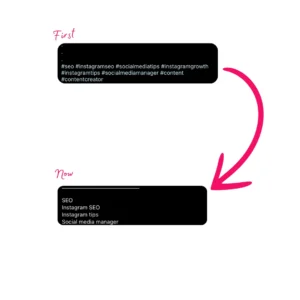Ahhhhh, hashtags – one of Instagram’s most debated topics. Do they still matter, where can I find the right ones, how many should I use? If you’re feeling completely lost, it’s perfectly normal. Instagram is a bit like the Hogwarts staircases: it loves changing the rules of the game! Lucky for you, this article is here to clear things up once and for all. And let’s start with a quick recap!
Once upon a time, hashtags ruled
There was a time when hashtags were the key to expanding your reach and getting your content seen by as many people as possible. Today, they seem to have lost some of their sparkle.
The platform has evolved. Now hashtags help Instagram categorize the topic of a post and show it to the most relevant audience. Essentially, they’re just labels! Their role changed in part because of spammy practices that made them less reliable (if not downright harmful), somewhat like the old keyword stuffing from the early days of SEO.
It’s no coincidence we’re talking about SEO – its rise as the new star challenger calls hashtags into question, prompting us to write this piece.
Who wins? If you’d rather skip the full read: they’re not enemies, just two sides of the same coin. 😏
Let’s dig deeper!
How does Instagram recommend content?
SEO, hashtags, and keywords all come together in this big pot we call “optimization.” The goal? To boost your posts’ reach and connect you with the right audience.
If you’ve checked out captions lately, you’ve probably noticed more and more posts ending with keyword lists instead of the usual hashtags. Why?

With its latest updates, Instagram has begun leveraging SEO to make it easier to find relevant content, a bit like TikTok has been doing for years. But what does that mean for you and your posts?
When you search for a keyword, Instagram picks out the content it believes is most relevant and displays it in the “For You” section.
SEO on Instagram: how does it work?
SEO – short for search engine optimization – is a well-known inbound marketing technique that’s been around for years on the web, drawing people in through search engines. On Instagram, the concept is similar: the algorithm reviews your profile and posts to figure out who should see them.
The keywords in your bio, posts, and Reels become critical in deciding which audience gets shown your content. They also help shape how Instagram labels your profile and associates you with certain categories – like travel, food, and so on.
So, is it enough to just pack your posts with keywords and call it a day? Not exactly…
The right approach to using keywords
There’s a lot of confusion around this, so let’s start from the basics.

Francesco Margherita – one of Italy’s most recognized SEO experts – explains this complicated little concept by saying:
Keywords are the beating heart of any SEO strategy… Essentially, they’re the words or phrases people type into search engines when they’re looking for information on a certain topic.
He then adds:
They’re closely tied to the search intent. Every time someone types a query into a search engine, they have a specific goal in mind. Keywords capture and address that intent, linking people to the content that best meets their needs.
It’s vital to understand that SEO isn’t just about captions, but your entire profile. It’s not enough to cram a single post full of keywords. Consistency and a strategic approach to these magic words across your whole profile are crucial.
And if you think about it, hashtags are basically keywords used in a different way. The real question is: what’s the best way to make use of them now?
No hashtag? No problem
Well, you could start by not using them at all!
One intriguing side effect of ditching hashtags is that it forces Instagram to show your content in the Explore page and among recommended posts simply because it can’t slot you into hashtag sections anymore.
This strategy could lead to greater visibility, displaying your content to people who don’t follow you yet. But careful: it’s no magic bullet. If your content isn’t relevant or well-optimized, you’ll still have a hard time gaining traction!
Keywords vs. hashtags: what should you do?
So you do want to use hashtags, but you’re unsure how to balance them with keywords? Let’s settle some doubts and reiterate:
- keywords or hashtags? Both are helpful, but they work differently. Hashtags label your content, while keywords teach the algorithm what it’s about
- where do I put keywords? Anywhere in your caption or at the end there’s essentially no difference
- overdoing it is always risky. Adding a never-ending list of keywords at the end of your post isn’t a great idea
As Veronica Gentili – a marketing expert never short on sharp insights – commented on our post, loading your caption with keywords is often sold as “the big secret to dominating visibility.” But remember: write for people, not just the algorithm.
She also points out how this approach recalls that old keyword stuffing we mentioned at the start of the article – an approach not only ineffective but penalized by Google’s algorithms.
🚨 It’s worth emphasizing that the same could happen someday on Instagram! Just look at the recent removal of the “Follow a hashtag” feature, scrapped precisely to fight spam and misuse.
In short: use keywords naturally and consistently within a solid editorial plan, and educate the algorithm over time. How? Keep reading to find out.
Bonus #1: use AI to write SEO-friendly content
If including keywords in your text without going overboard feels tricky, don’t worry! You can write your caption first, then use AI to blend in the keywords smoothly and naturally.
This small step can make a big difference in ensuring your content is SEO-friendly without sounding forced.
Bonus #2: use NJL to level up your SEO strategy
If you’re looking to fine-tune your approach, there are three sections in NJL we suggest checking regularly.
First, there’s Caption Analysis – available with our Standard and Pro plans.

These charts give you an immediate snapshot of how effective your captions are. You’ll quickly see how text length impacts comments, saves, and overall engagement.
💡 But be warned: even if NJL offers plenty of hints – don’t let them box in your creativity!
Moving on, there’s the new Search Hashtags section, which now:
✅ implements Instagram’s official API
✅ leverages AI to recommend thematically relevant hashtags
This can help you find the best-fitting hashtags for a post, matching the thematic consistency (aka SEO) that Instagram now uses to categorize content. Here, you can:
- search for hashtags by typing a phrase – like adventurous travel in Europe
- or by context – like mom traveling with dogs in the mountains
- start with one hashtag to find related ones – just type a word in the search field
Feeling curious? Check out the tool in action!
Last but not least is the SEO Hashtag tab – just rebuilt from the ground up to suit hashtags’ new role on the platform.
Besides keeping an eye out for dreaded banned hashtags, this section is the go-to spot for checking how relevant your chosen hashtags are to your profile’s topics and how well they fit the posts you’ve published. Thanks to a simple evaluation system, you’ll immediately see whether there’s room for improvement and get a sense of how Instagram views your profile.
In other words, NJL can do the SEO-magic for you. 😉
So, what’s the bottom line?
Are hashtags still useful on Instagram?
✅ Yes, but their function has changed. They’re still relevant, yet SEO is quickly gaining ground.
How do I optimize my Instagram profile for SEO?
💡 Use relevant keywords in your username, bio, and posts. Make sure your content is both consistent and high-quality.
In this NJL, the “SEO Analysis” feature comes to your aid. Read here to find out how it works!
Does SEO completely replace hashtags?
🫸 No, SEO doesn’t fully replace hashtags; it just offers an additional way to increase your posts’ visibility.
What if I throw a thousand keywords at the end of my post?
😭 You’ll sabotage yourself. Go back to the start of the article!
And if I don’t use NJL?
💔 You’ll break our hearts and miss out on the fun side of data… but there’s always time to fix that. Just activate a plan, and your hashtag anxiety will soon be #waterunderthebridge!

Leave a Reply